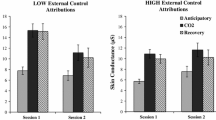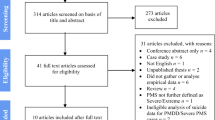Abstract
Women with panic disorder are likely to experience greater menstrual-specific symptoms (e.g., headaches, cramps) as well as more panic/anxiety-related symptoms (e.g., dizziness, faintness, chest pain, heart pounding), and may be more likely to experience these symptoms during the premenstrual phase. This study examines the attributions women make about the somatic and affective symptoms they experience during the menstrual cycle. Using a 30-day prospective design, women with and without panic disorder monitored physical and affective symptoms. Participants reported on severity of various symptoms and a primary cause for each symptom (menstrual cycle-related, panic/anxiety related, stress-related, health-related). Women with panic disorder reported more panic attacks during the premenstrual phase compared to other cycle phases. They also reported more severe affective and panic symptoms during the premenstrual phase compared to other phases, but did not significantly differ from the comparison group in menstrual symptom severity across the three cycle phases. Although women with panic disorder attributed more panic/anxiety-related causes for their symptoms across the menstrual cycle, they were able to discriminate between panic/anxiety causes and menstrual cycle-related causes. Women with panic disorder may benefit for therapy that focuses on their exacerbation of panic symptoms during the premenstrual phase.

Similar content being viewed by others
Notes
We examined whether participants made different attributions depending on the types of symptoms they experienced. Given that participants differed in the number of symptoms they may have reported, 12 proportional scores were derived from the number of attributions reported divided by the number of symptoms reported for each symptom type across each menstrual cycle phase. The results from the proportional scores mirror the presented results.
References
Ahmad, T., Wardle, J., & Hayward, P. (1992). Physical symptoms and illness attributions in agoraphobia and panic. Behaviour Research and Therapy, 30, 493–500.
American Psychiatric Association. (2000). Diagnostic and statistical manual of mental disorders (text revision) (4th ed.). Washington, DC: Author.
Brown, T. A., DiNardo, P., & Barlow, D. H. (2004). Anxiety disorders interview schedule for DSM-IV (ADIS-IV). New York, NY: Oxford University Press.
Calkins, A. W., Otto, M. W., Cohen, L. S., Soares, C. N., Vitonis, A. F., Hearon, B. A., et al. (2009). Psychosocial predictors of the onset of anxiety disorders in women: Results from a prospective 3-year longitudinal study. Journal of Anxiety Disorders, 23, 1165–1169.
Cameron, O. G., Kuttesch, D., McPhee, K., & Curtis, G. C. (1988). Menstrual fluctuations in the symptoms of panic anxiety. Journal of Anxiety Disorders, 15, 169–174.
Cioffi, D. (1991). Beyond attentional strategies: A cognitive-perceptual model of somatic interpretation. Psychological Bulletin, 109, 25–41.
Clark, D. M. (1986). A cognitive approach to panic. Behaviour Research and Therapy, 24, 461–470.
Kamieniecki, G. W., Wade, T., & Tsourtos, G. (1997). Interpretative bias for benign sensations in panic disorder with agoraphobia. Journal of Anxiety Disorders, 11, 141–156.
Kaspi, S. P., Otto, M. W., Pollack, M. H., Eppinger, S., & Rosenbaum, J. F. (1994). Premenstrual exacerbation of symptoms in women with panic disorder. Journal of Anxiety Disorders, 8, 131–138.
Moos, R. H. (1985). Perimenstrual symptoms: A manual and overview of research with the Menstrual Distress Questionnaire. Stanford, CA: Author.
Nillni, Y. I., Rohan, K. J., Bernstein, A., & Zvolensky, M. J. (2010). Premenstrual distress predicts panic-relevant responding to a CO2 challenge among young adult females. Journal of Anxiety Disorders, 24(4), 416–422.
Norton, G. R., Dorward, J., & Cox, B. J. (1986). Factors associated with panic attacks in nonclinical subjects. Behavior Therapy, 17, 239–252.
Olatunji, B. O., & Wolitzky-Taylor, K. B. (2009). Anxiety sensitivity and the anxiety disorders: A meta-analytic review and synthesis. Psychological Bulletin, 135, 974–999.
Peterson, R. A., & Reiss, S. (1987). Test manual for the Anxiety Sensitivity Index. Palos Heights, IL: International Diagnostic Systems.
Pilecki, B., Arentoft, A., & McKay, D. (2011). An evidence-based causal model of panic disorder. Journal of Anxiety Disorders, 25, 381–388.
Plehn, K., & Peterson, R. A. (2002). Anxiety sensitivity as a predictor of the development of panic symptoms, panic attacks, and panic disorder: A prospective study. Journal of Anxiety Disorders, 16, 455–474.
Reiss, S., & McNally, R. J. (1985). Expectancy model of fear. In S. Reiss & R. R. Bootzin (Eds.), Theoretical issues in behavior therapy (pp. 107–121). San Diego: Academic Press.
Schartel, J. G., Edenfield, T. A., Hermann, B. A., LaMattina, S. M., Pells, J. J., Tower, R. D., et al. (2004). Response styles, sex roles, and the experience of gender-specific stressors in women. Poster presented at the annual meeting of the Association for Behavioral and Cognitive Therapies, New Orleans, LA.
Schmidt, N. B., Lerew, D. R., & Jackson, R. J. (1999). Prospective evaluation of anxiety sensitivity in the pathogenesis of panic: Replication and extension. Journal of Abnormal Psychology, 108, 532–537.
Schmidt, N. B., Zvolensky, M. J., & Maner, J. K. (2006). Anxiety sensitivity: Prospective prediction of panic attacks and Axis I pathology. Journal of Psychiatric Research, 40, 691–699.
Sheikh, J. I., Leskin, G. A., & Klein, D. F. (2002). Gender differences in panic disorder: Findings from the National Comorbidity Survey. American Journal of Psychiatry, 159, 55–58.
Sigmon, S. T. (2002). The development and validation of the Daily Symptom Checklist for menstrual and anxiety symptoms. Unpublished manuscript.
Sigmon, S. T., Dorhofer, D. M., Rohan, K. J., & Boulard, N. E. (2000a). The impact of activity sensitivity, bodily expectations, and cultural beliefs on menstrual symptoms reporting: A test of the menstrual reactivity hypothesis. Journal of Anxiety Disorders, 14, 615–633.
Sigmon, S. T., Dorhofer, D. M., Rohan, K. J., Hotovy, L. A., Boulard, N. E., & Fink, C. M. (2000b). Psychophysiological, somatic, and affective changes across the menstrual cycle in women with panic disorder. Journal of Consulting and Clinical Psychology, 68, 425–431.
Sigmon, S. T., Fink, C. M., Rohan, K., & Hotovy, L. A. (1996). Anxiety sensitivity and menstrual cycle reactivity: Psychophysiological and self-report differences. Journal of Anxiety Disorders, 10, 393–410.
Sigmon, S. T., Rohan, K. J., Boulard, N. E., Dorhofer, D. M., & Whitcomb, S. R. (2000c). Menstrual reactivity: The role of gender-specificity, anxiety sensitivity, and somatic concerns in self-reported menstrual distress. Sex Roles, 43, 143–161.
Sigmon, S. T., & Schartel, J. G. (2008). Anxiety, anxiety disorders, and the menstrual cycle. In M. J. Zvolensky & J. A. J. Smits (Eds.), Anxiety in health behaviors and physical illness (pp. 181–205). New York: Springer.
Sigmon, S. T., Schartel, J. G., Edenfield, T. M., Hermann, B. A., Pells, J. J., & LaMattina, S. M. (2006). Premenstrual symptom discrimination in women with panic disorder. Poster presented at the annual meeting of the Anxiety Disorders Association of America, Miami, FL.
Stewart, S. H., Taylor, S. J., Jang, K. L., Cox, B. J., Fedoroff, I. C., & Borger, S. C. (2001). Causal modeling of relations among learning history, anxiety sensitivity, and panic attack. Behaviour Research and Therapy, 39, 443–456.
Teachman, B. A., Smith-Janek, S. B., & Saporito, J. (2007). Information processing biases and panic disorder: Relationships among cognitive and symptom measures. Behaviour Research and Therapy, 45, 1791–1811.
Author information
Authors and Affiliations
Corresponding author
Ethics declarations
Conflict of interest
The authors report no conflicts of interest.
Rights and permissions
About this article
Cite this article
Haigh, E.A.P., Craner, J.R., Sigmon, S.T. et al. Symptom Attributions Across the Menstrual Cycle in Women with Panic Disorder. J Rat-Emo Cognitive-Behav Ther 36, 320–332 (2018). https://doi.org/10.1007/s10942-018-0288-4
Published:
Issue Date:
DOI: https://doi.org/10.1007/s10942-018-0288-4




